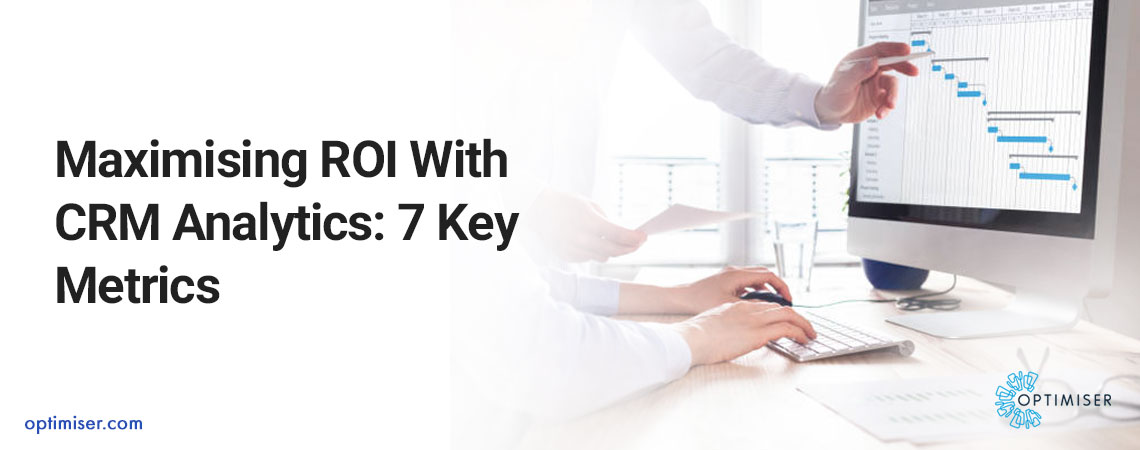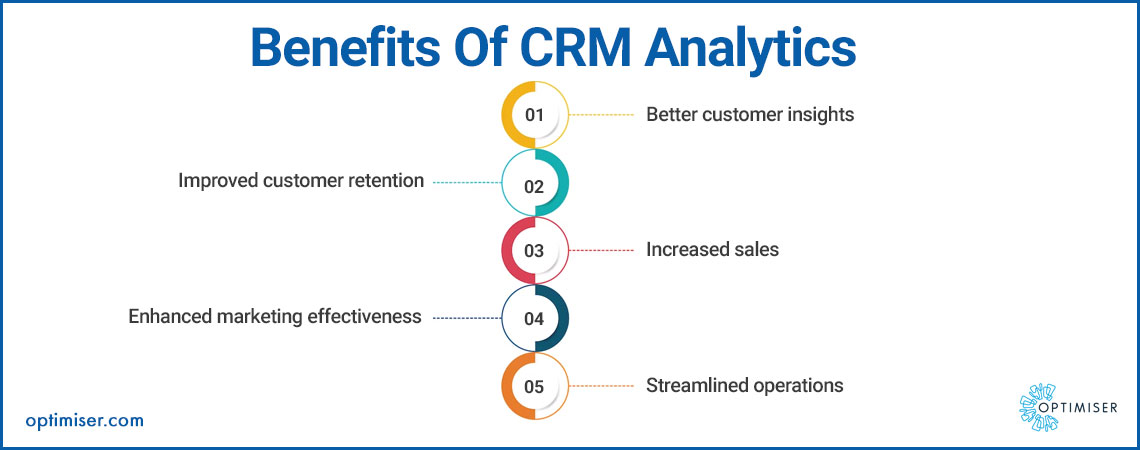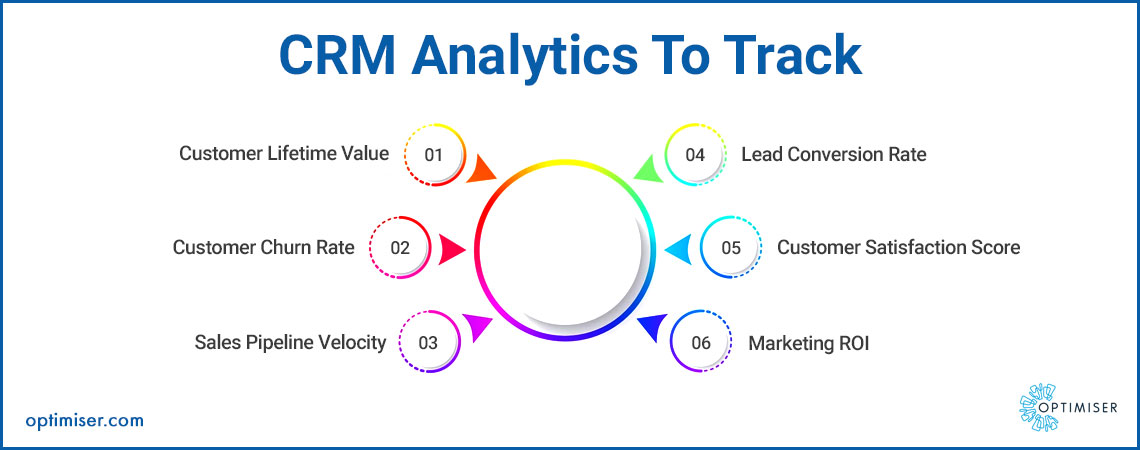
Maximising ROI With CRM Analytics: 7 Key Metrics
CRM analytics is the process of gathering and analysing data from customer interactions and behaviours to gain insights and make informed business decisions. It involves applying various analytical techniques to gain insights and extract valuable information that can be used to enhance customer relationships and drive business growth.
CRM analyst reports come from multiple sources, such as customer profiles, sales transactions, customer service interactions, marketing campaigns, and website usage. By analysing this data, businesses can uncover patterns, trends, and correlations to understand customer preferences, behaviours, and needs.
Benefits Of Tracking CRM Analytics
- Enhanced Customer Understanding: One of the best features of analytical CRM is that it provides deep insights into customer preferences, behaviours, and needs. By analysing customer data, businesses can gain a better understanding of their target audience, enabling them to tailor their products, services, and marketing strategies to meet specific customer demands.
- Improved Sales And Marketing Efforts: CRM analytics enables businesses to track and analyse sales data, customer interactions, and marketing campaigns. This data-driven approach helps identify successful sales and marketing strategies, optimise lead generation, target high-value customers, and allocate resources more effectively. It also enables businesses to personalise marketing messages and offers, resulting in higher conversion rates and increased sales.

- Enhanced Customer Service: By analysing customer support data and feedback, businesses can identify trends, common issues, and areas for improvement. This allows them to proactively address customer concerns, provide faster and more effective customer service, and ultimately increase customer retention and loyalty.
- Predictive Analytics: CRM analytics enables businesses to leverage predictive modelling and forecasting techniques. By analysing historical data and patterns, businesses can predict customer behaviour, identify potential upselling or cross-selling opportunities, anticipate customer churn, and take proactive measures to retain valuable customers.
- Data-Driven Decision Making: CRM analytics empowers businesses with data-driven decision-making. It enables managers and executives to access real-time and comprehensive insights into customer interactions, sales performance, marketing effectiveness, and overall business metrics. This helps in identifying trends, making informed strategic decisions, and optimising business processes for better outcomes.
Important CRM Metrics To Track
- Customer Acquisition Cost (CAC): The cost incurred to acquire a new customer. It includes expenses related to marketing campaigns, sales efforts, advertising, and lead generation. Calculating CAC helps businesses assess the efficiency and profitability of their customer acquisition strategies.
- Customer Lifetime Value (CLV): Total revenue generated from a customer over their lifetime with the company. It takes into account repeat purchases, average order value, and retention rate. CLV helps businesses understand the long-term value of their customers and make informed decisions regarding customer retention and acquisition efforts.
- Customer Churn Rate: Churn rate measures the percentage of customers who stop doing business with a company over a specific period. It provides insights into customer retention and loyalty. By monitoring churn rate, businesses can identify potential issues, improve customer service, and implement strategies to reduce customer attrition.
- Conversion Rate: The conversion rate measures the percentage of leads or prospects that convert into paying customers. It helps assess the effectiveness of sales and marketing efforts. By tracking conversion rates at different stages of the sales funnel, businesses can identify bottlenecks and optimise their conversion strategies.
- Customer Satisfaction (CSAT) Score: CSAT score measures customer satisfaction levels based on surveys, feedback, or ratings. It provides an indication of how well a company meets customer expectations. Monitoring CSAT scores helps identify areas for improvement, enhance customer experience, and build stronger relationships with customers.
- Lead To Customer Conversion Rate: It is the percentage of leads that convert into customers. It provides insights into the effectiveness of lead generation and nurturing efforts. Monitoring lead-to-customer conversion rate helps businesses evaluate the quality of leads and optimise lead management strategies.
- Return on Investment (ROI): ROI measures the financial return on CRM investments. It compares the gains or benefits derived from CRM initiatives to the costs incurred. Monitoring ROI helps businesses assess the profitability and effectiveness of their CRM strategies and make informed decisions regarding resource allocation.

Also Read: The Ultimate Guide To Choosing The Right Website Builder For Event Marketing
Other CRM Metrics To Track
- Upsell/Cross-sell Revenue: Upsell/cross-sell revenue measures the additional revenue generated by selling upgraded or complementary products or services to existing customers. It reflects the success of upselling and cross-selling strategies in increasing customer value. Tracking upsell/cross-sell revenue helps identify opportunities to maximise customer lifetime value.
- Retention cost: Retention cost is the expenses incurred by a company to retain existing customers over a specific period. Understanding retention costs helps businesses assess the effectiveness of their customer retention strategies and evaluate the return on investment (ROI) associated with retaining customers. By monitoring and optimising retention costs, companies can allocate resources efficiently, improve customer retention rates, and maximise the profitability of their existing customer base.
Using Optimiser CRM For Analysing Essential Metrics
By utilising Optimiser CRM reports and dashboards, businesses gain insights into sales performance, customer acquisition costs, customer retention rates, and other critical indicators. The platform allows businesses to define and monitor key performance indicators (KPIs) aligned with their goals. Customisable fields and data points capture relevant metrics accurately, while automation tools streamline data collection from various sources. Custom reports and dashboards provide visual representations of the tracked metrics, facilitating real-time monitoring and analysis. These insights help identify areas for improvement, optimise sales and marketing strategies, enhance customer experiences, and ultimately drive business growth.
Summary
Utilising CRM analytics effectively can provide a competitive edge. By harnessing data and insights, businesses can identify market trends, understand customer needs better than competitors, and respond quickly to changing market dynamics. This positions them to adapt their strategies and offerings in a more agile and customer-centric manner, gaining a competitive advantage in the market.

30 days free trial. No credit card required
 One powerful platform
One powerful platform
 Simple to use
Simple to use
 Comprehensive
Comprehensive



